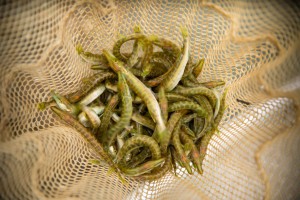Utah anglers may soon be affected by the Department of Wildlife Resources’ (DWR) efforts to modify fishing laws and strengthen the population of tiger muskies, potentially changing the fishing experience throughout the state.

The Department is currently seeking feedback on the proposed changes that expand the Utah possession limit and tweak catch-and-kill regulations through the state — changes that could give fishermen more options.
“Utah’s fishing waters belong to you,” said Drew Cushing, warm-water sports fisheries coordinator for the DWR. “We want you to speak up and let us know what you think of our proposed changes for 2014.”
The main change involves a modification to the current possession limit. This limit means, for example, if an angler stores fish in his or her freezer, another fish cannot be caught until at least one of the fish is eaten. DWR biologists are recommending that the possession limit be changed to twice the daily bag limit. The bag limit (usually four per day) is currently the same as the possession limit.
Doubling the possession limit could encourage fishermen to fish farther away from their homes during two-day fishing trips, something that has been difficult to this point.
“If (BYU students) wanted to go and take a holiday weekend and go and take more than four fish or eight fish or whatever the limit is then they would be free to do that,” said Mike Slater, a regional aquatics director for the DWR.
For Jordan Nielsen, a senior studying economics from Beaverton, Ore., who fishes frequently through the year, the proposed changes seem to open some new opportunities.

“As long as there are no long-term consequences for the ecosystem or anything like that I have no problems with the changes,” he said.
Another major proposed change modifies the catch-and-kill regulations in Utah. Ten bodies of water in the state have catch-and-kill regulations that require certain species of fish to be killed if caught. According to biologists, this practice helps to control the population of fish that have been stocked illegally.
Another current law requires that fish not be wasted — meaning the fish must be eaten. The proposal for 2014 would not require fish to be eaten at catch-and-kill waters.
“If I went somewhere and they told me to eat the junk fish I don’t know if I could follow that,” Nielsen said of the current law. “I don’t have any problem with just getting rid of those fish.”
In addition to the proposal to change how people fish, the DWR is also working to expand what Utahns can fish. On Aug. 23, more than 4,000 tiger muskies were released into various waters in Utah (including Joe’s Valley, nearby). The tigers were 3–5 inches when placed and will be 15 inches long by next year and will grow to more than 4 feet in the next five to six years.
“It’s something different. These fish can be 40–50 inches long; it’s something different and something new,” Slater said. “We are trying to bring them in here where we feel it’s safe and it won’t cause problems with other fish and give people a chance to catch a really aggressive fish.”
The proposals are currently being reviewed by the Department of Wildlife Resources’ Regional Advisory Councils (RAC), which will then provide input to the Utah Wildlife Board. The board will decide on the changes in Salt Lake City on Nov. 7.
Those in the BYU community who are interested in providing input on the proposal may attend a RAC meeting on Sept. 17 at 6:30 p.m. in the DNR Salt Lake office auditorium (1594 W. North Temple). Citizens can also provide feedback via email. Visit wildlife.utah.gov for more details about providing information to the RAC.
“We love hearing from the public, and you would be really surprised at how far those suggestions go,” Slater said. “My job is to manage their fish. They’re not my fish, they’re the public’s fish, so the more input we can get the more direction we can get about where we need to go.”
For more information about where to find tiger muskies, see the Department of Wildlife Resources website at http://1.usa.gov/17l6JrD.




